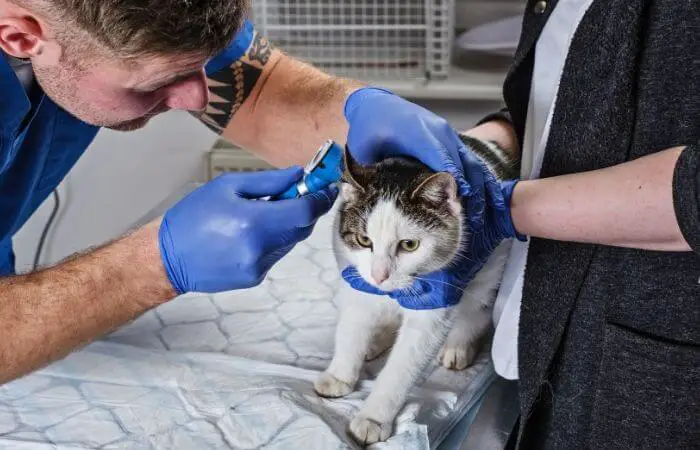Cat mange can be challenging to treat compared to typical parasite infestations, effective cat mange treatment will need to be prescribed by a vet.
There are several options available, from dips and baths to insecticide sprays, spot-on solutions, and even oral medication.
To find out more about cat mange, in general, and how it can be treated, keep on reading.
Contents
What Is Cat Mange?
Cat mange is an infestation of mites which get underneath the skin causing hair loss, itchiness and scabbing.
Mange comes in a number of different forms depending on the type of parasite it is caused by:
1. Scabies
Scabies is caused by a very contagious parasite called Notoedres cati. Scabies can also be caused by the typical dog parasite, Sarcoptes scabiei, when a cat comes in contact with an infected canine.
Fortunately, cases of scabies in cats have become rarer as pet parents have begun to practice good parasite control and prevention.

In terms of symptoms, scabies is one of the itchiest types of mange that can affect cats.
It causes hair loss and skin crusts, which typically show up on the animal’s head and neck and around its ears. In severe cases, hair loss can be present across the entire body surface.
Spot-on and injectable medications can be used to treat scabies, but the therapy often involves repeated applications to make sure that all the larvae and adults are killed.
2. Ear mites
Otodectic mange is caused by a parasite called Otodectes cynotis.
This mite has a penchant for the external ear canal and while it can affect other animals (such as dogs), it is particularly common in cats.
If your pet has ear mites, you’ll probably notice constant ear scratching and head shaking.
Some severe infestations can involve the parasite leaving the ear canal and burrowing in other body areas, but this rarely happens.

Fortunately, otodectic mange is among the easiest to treat nowadays, and most therapy options rely on the use of ear drops or ointments.
You do have to make sure that the cat’s ear is as clean as possible before applying the treatment so that it penetrates the external ear canal’s skin layer.
Since this type of mange is also contagious, treating animals that have come in contact with the ones that have been diagnosed can be a good way of preventing more severe infestations and ear infections.
When left untreated, ear mange can lead to severe otitis (inflammation of the ear canal).
3. Demodicosis
There are two types of parasites that cause demodicosis in cats, they are the following:
- Demodex cati
- Demodex gatoi
While the first is known to affect many adults to some extent or the other, the second usually appears in younger cats and is more contagious than its counterpart.
What’s interesting about demodicosis is that the parasites often live on the cat’s body without causing any particular issue.
The cats can lead perfectly normal lives until the infestation becomes severe on account of them developing other immunocompromising conditions.
For instance, cats that have FIV, FeLV, or diabetes are more exposed to developing a severe form of demodicosis, no matter the type of parasite it is caused by.
Moreover, some animals can develop ringworm and this type of mange at the same time, making the treatment a little more challenging than usual.
Luckily, most therapies offer results in a short amount of time, and the majority of cats recover in less than a month. Some types of treatments do have to be applied every week for 4-5 weeks, though, such as lime sulfur dips.
Luckily, most therapies offer results in a short amount of time, and the majority of cats recover in less than a month.
Some types of treatments do have to be applied every week for 4-5 weeks, though, such as lime sulfur dips.
4. Walking dandruff
This type of mange rarely leads to any health problems or symptoms.
While it is caused by an extremely contagious parasite, Cheyletiella blakei, most cats don’t even notice it.

Some cats can develop intense itching, along with bumps and skin crusts, but others may not show any signs at all and could be accidental carriers and transmitters to other felines.
Walking dandruff can be treated using a variety of insecticides and product forms – from insecticide dips to spot-on solutions and sprays.
Injections can be useful for cats that can’t stand other therapies, and there are oral drugs available, too.
5. Fur mites
This health problem can show up in cats that live in warm climates such as Australia, Hawaii, Brazil, and some parts of the United States such as Texas or Florida.
It’s less likely for humans to get Lynxacarus radovskyi, the parasite responsible for the condition, from cats.

The mites cause the same classic symptoms you might notice in other mange types, such as itching, skin inflammation, and hair loss.
How do cats get mange?
Mange can be transmitted from one infected cat to a perfectly healthy one.
The likelihood of indoor cats getting it is approximately non-existent if they don’t go outside at all.
Outdoor cats, on the other hand, have a higher chance of getting mange from other animals and other cats.
While there haven’t been enough studies performed in this sense, there is the possibility of humans being intermediary hosts and passing on the parasites to their cats, too.
Ask a Vet
Worried about your cat having mange? Speak with a vet ASAP to help you work out what’s going on and what needs to be done. JustAnswer allows you to talk in real-time to veterinary experts for a small fee.
How are mites different from fleas and ticks?
Mange is caused by several different kinds of mites, but they are parasites that do not resemble the typical ectoparasites most cats get at one point.
Ticks and fleas are classic external parasites, and while they do penetrate the animal’s skin in order to feed, they will not burrow canals under the epidermis.
Compared to fleas and ticks, mites are very small in size. Since their bodies usually measure less than 1 mm, this makes it very hard, if not impossible, to see them.
How is cat mange diagnosed?
If you notice any of the symptoms that we have mentioned, the best way to go about things is to take your pet to the vet clinic as soon as possible.
Once there, you will be asked what clinical signs you’ve seen, so be prepared to have all the information ready.
The most useful test that can be performed to diagnose the specific type of mange that a cat suffers from is a skin scraping.
The technique is effective in most cases, but in order for it to be relevant, veterinarians often have to collect samples from three or more points across the cat’s body.
Otherwise, a single sample might not contain any traces of a parasite and will merely have skin detritus, and that is what will be examined under the microscope.
How to treat cat mange
If your cat has mange the likelihood of any homemade remedies working is very low.
That’s because the mites are located under the first layer of skin, not on its surface.
There are a variety of therapies available all of which have to be prescribed by a veterinarian.
Here are some examples of medications that can be used for treating cat mange:
- Lime sulfur dips (weekly treatments for up to 6 weeks)
- Topical products such as those containing Selamectin and Fipronil
- Injections with Ivermectin or Doramectin
The vet will tell you which one of these you should use, but you should know that they offer different results depending on the type of mange that your cat has.
For example, Selamectin (contained by Revolution), Fluralaner (Bravecto) and Sarolaner (Revolution Plus) can work for sarcoptic mange.
Ivermectin works for scabies too, but it also offers great results for other types of mites, including demodicosis.
Amitraz or lime sulfur baths work for most cat mange types, but due to their strong scent (and the reticence of most cats to have a bath!), they’re very difficult to use.
Since these insecticides can have serious side effects, applying the treatment at home should only be done under the guidance of a veterinarian.
This is even more important for kittens and geriatric cats, whose immune systems might not be able to handle the aggression of such strong medication.
Treating feral cats with mange is almost impossible unless performed under anaesthesia.
Can cat mange be transmitted to people?
Yes.
Scabies is the most common type of mange that can be caught by humans from their cat.
It causes the same symptoms in people as it does in cats, meaning intense itching, scaling, and raised skin lesions.
Scabies is also very contagious to other animals, so if you have a household where several cats and dogs live, they will have to get preventative treatment, too.
Preventing cat mange
Using flea and tick treatments, whether topical or oral, on a regular basis, can prevent mange in cats.
Furthermore, outdoor pets have a much higher likelihood of contracting the disease from other animals, so ideally you should keep your cat exclusively indoors.
If you interact with other cats outside your home, make sure to wash your hands before touching your own pet.
Although some cats can be mite carriers, they may never develop symptoms if they are properly taken care of.
Make sure that your cat has access to clean water, good food, and a clean living environment.
Take your pets to the vet once or twice a year for regular checkups to prevent them from developing conditions that might complicate mange and other diseases.
As an Amazon Associate I may earn a small fee from qualifying purchases at no extra cost to you. This helps us run the site, so thanks for your support!








Leave a Comment